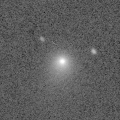
|
Now it is 9.9 mag (May 28, Alexandre Amorim). It is expected to keep so bright as 6-8 mag for a long time from 2011 to 2012, and to be observable in good condition in the Northern Hemisphere. In the Southern Hemisphere, it keeps observable in good condition until October when it brightens up to 6.5 mag.
Date(TT) R.A. (2000) Decl. Delta r Elong. m1 Best Time(A, h)
May 28 23 1.84 -5 3.2 3.065 3.083 81 10.3 5:27 (214, 55)
June 4 23 0.96 -3 40.3 2.876 3.015 87 10.1 5:30 (200, 57)
|
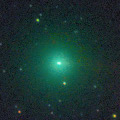
|
It approached to the sun down to 0.88 A.U. in mid April, and it brightened up to 8.6 mag (Apr. 13, Juan Jose Gonzalez). Now it is fading, but it is still bright as 11.0 mag (May 26, Con Stoitsis). It keeps observable until it fades out, although it keeps locating somewhat low in the morning sky. It will be fainter than 18 mag in July.
Date(TT) R.A. (2000) Decl. Delta r Elong. m1 Best Time(A, h)
May 28 0 51.75 14 12.3 1.499 1.136 49 12.8 5:27 (230, 24)
June 4 1 10.61 15 2.7 1.555 1.214 51 13.6 5:30 (227, 25)
|
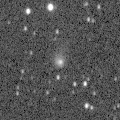
|
Now it is bright and visible visually at 13.2 mag (May 14, Chris Wyatt). It keeps bright as 13-14 mag for a long time after this until 2013. It is not observable in the Northern Hemisphere, but it is observable in good condition in the Southern Hemisphere.
Date(TT) R.A. (2000) Decl. Delta r Elong. m1 Best Time(A, h)
May 28 12 12.08 -82 7.6 5.183 5.685 114 13.5 19:48 ( 0, 43)
June 4 11 42.80 -81 21.2 5.179 5.671 114 13.5 18:51 ( 0, 44)
|

|
First return of a new periodic comet which brightened up to 13 mag in a major outburst in 2005. When appearing in the morning sky in early April, it was unexpectedly bright as 14.3 mag (Apr. 5, Hidetaka Sato). Now it is visible visually at 13.8 mag (May 8, Alan Hale). It will be getting higher gradually after this, and will be observable in an excellent condition from summer to winter.
Date(TT) R.A. (2000) Decl. Delta r Elong. m1 Best Time(A, h)
May 28 22 37.20 -9 32.8 1.890 2.127 88 13.7 5:27 (207, 62)
June 4 22 46.21 -8 5.7 1.815 2.124 92 13.6 5:30 (195, 62)
|

|
It will be 12-13 mag in June and July. However, it is not observable at all due to the bad condition in this apparition.
Date(TT) R.A. (2000) Decl. Delta r Elong. m1 Best Time(A, h)
May 28 5 31.20 23 48.7 2.370 1.434 17 14.4 18:27 (116, -5)
June 4 5 55.65 24 28.4 2.361 1.415 16 13.8 18:25 (116, -6)
|

|
Now it is bright as 11.8 mag and visible visually (May 22, Juan Jose Gonzalez).
Date(TT) R.A. (2000) Decl. Delta r Elong. m1 Best Time(A, h)
May 28 10 43.22 1 36.0 6.078 6.256 95 13.9 18:27 (178, 53)
June 4 10 44.69 1 30.4 6.189 6.257 89 13.9 18:25 (167, 53)
|
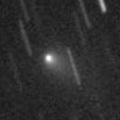
|
Now it is 13.5 mag and visible visually (May 28, Carlos Labordena). It will brighten up to 12 mag in autumn. In the Northern Hemisphere, it keeps observable for a long time until 2012 spring. In the Southern Hemisphere, it is not observable until November. A small outburst occured and it brightened by 2 mag on 2010 Aug. 31 (Bernhard Haeusler). Recent brightening is somewhat slower than expected.
Date(TT) R.A. (2000) Decl. Delta r Elong. m1 Best Time(A, h)
May 28 6 24.50 83 28.1 2.566 2.295 63 13.9 18:27 (173,-32)
June 4 6 48.14 80 16.0 2.595 2.254 59 13.9 18:25 (169,-31)
|
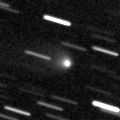
|
Now it is 14.5 mag and visible visually (May 26, Jakub Cerny). It will be observable at 13-14 mag for a long time from 2011 to 2012.
Date(TT) R.A. (2000) Decl. Delta r Elong. m1 Best Time(A, h)
May 28 20 7.20 -4 40.8 5.083 5.684 121 14.2 3:48 (180, 60)
June 4 20 0.90 -4 44.2 4.960 5.662 129 14.1 3:14 (180, 60)
|
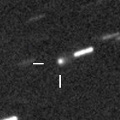
|
It will approach to the sun down to 0.5 A.U. in September, and it is expected to brighten up to 6 mag. Now it is 13.3 mag and visible visually (May 28, Carlos Labordena). In the Southern Hemisphere, it keeps observable until early September when it becomes 7 mag. In the Northern Hemisphere, it becomes unobservable in August. But after appearing in the morning sky in October, it becomes observable in the excellent condition at midnight.
Date(TT) R.A. (2000) Decl. Delta r Elong. m1 Best Time(A, h)
May 28 10 26.97 8 13.9 1.834 2.084 89 14.5 18:27 (172, 47)
June 4 10 27.70 8 11.3 1.833 1.980 82 14.3 18:25 (163, 45)
|

|
Big asteroid discovered in 1906. It suddenly showed the cometary activity on Dec. 11, probably due to an impact of a small object. It was very bright as 11.5 mag visually (Dec. 17, Juan Jose Gonzalez). It had a dust coma still on Jan. 9 (Joseph Brimacombe). Now it is stellar at 13.8 mag (Apr. 5, Juan Jose Gonzalez).
Date(TT) R.A. (2000) Decl. Delta r Elong. m1 Best Time(A, h)
May 28 9 36.80 28 53.4 2.996 2.840 71 14.5 18:27 (163, 24)
June 4 9 44.78 27 51.8 3.069 2.828 66 14.6 18:25 (158, 24)
|
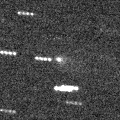
|
Now it is 15.4 mag (May 14, Ken-ichi Kadota). The condition in this apparition is bad. It locates high in the Southern Hemisphere, however, it locates extremely low in the Northern Hemisphere. It will be fading gradually, and will be fainter than 18 mag in September.
Date(TT) R.A. (2000) Decl. Delta r Elong. m1 Best Time(A, h)
May 28 23 41.15 -13 0.4 1.973 1.987 75 14.9 5:27 (237, 56)
June 4 23 51.45 -12 29.1 1.939 2.027 80 15.1 5:30 (229, 59)
|
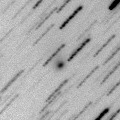
|
It reached up to 13.3 mag, much brighter than originally expected, and visible visually (Jan. 24, Juan Jose Gonzalez). Now it is fading slowly, but still bright as 14.1 mag (May 16, Hidetaka Sato). It will be higher after this, and observable at 15 mag in good condition until autumn.
Date(TT) R.A. (2000) Decl. Delta r Elong. m1 Best Time(A, h)
May 28 23 53.84 12 42.7 3.133 2.824 63 14.9 5:27 (218, 34)
June 4 23 56.19 11 38.3 3.050 2.857 69 15.0 5:30 (211, 38)
|
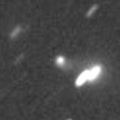
|
Now it is 15.8 mag (May 26, A. Novichonok and D. Chestnov). It keeps 15 mag from 2011 summer to 2012 summer. But it is not observable around the perihelion. It is observable in good condition in the Northern Hemisphere in 2011, and in the Southern Hemisphere in 2012.
Date(TT) R.A. (2000) Decl. Delta r Elong. m1 Best Time(A, h)
May 28 13 8.41 26 48.7 2.671 3.213 113 15.7 20:46 (180, 28)
June 4 13 8.06 26 6.6 2.694 3.164 108 15.7 20:18 (180, 29)
|

|
It has returned after 27-year blank since 1984. Now it is 17.6 mag (May 29, L. Elenin, I. Molotov). It will approach to the sun down to 0.75 A.U. and brighten up to 10.5 mag in July and August. However, the condition of this apparition is bad. It locates extremely low, and only observable until mid July in the Northern Hemisphere. It locates extremely low and hard to observe in the Southern Hemisphere.
Date(TT) R.A. (2000) Decl. Delta r Elong. m1 Best Time(A, h)
May 28 1 19.10 29 27.1 2.007 1.406 40 16.5 5:27 (225, 8)
June 4 1 48.57 31 6.3 1.912 1.314 40 15.8 5:30 (223, 7)
|
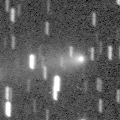
|
It reached up to 14.0 mag and became visible visually in December (Dec. 17, Juan Jose Gonzalez). Then it has been fading, and faded down to 18.3 mag on Mar. 31 (Yasukazu Ikari). However, it brightened up to 16 mag in outburst on Apr. 5. Then it keeps brightening and reached up to 14.7 mag now (May 28, Hidetaka Sato). It locates low in the Southern Hemisphere. It will be getting lower gradually after this in the Northern Hemisphere.
Date(TT) R.A. (2000) Decl. Delta r Elong. m1 Best Time(A, h)
May 28 8 33.54 37 58.0 3.175 2.757 56 15.9 18:27 (154, 11)
June 4 8 46.24 37 6.5 3.271 2.786 53 16.2 18:25 (151, 10)
|
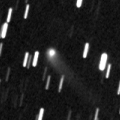
|
Now it is 16.3 mag (May 18, P. Dupouy). It will be fading very slowly after this. In the Northern Hemisphere, it keeps observable for a long time until 2012 spring when it fades down to 17-18 mag. It will not be observable in the Southern Hemisphere.
Date(TT) R.A. (2000) Decl. Delta r Elong. m1 Best Time(A, h)
May 28 22 41.78 47 21.3 5.155 4.909 70 16.0 5:27 (189, 7)
June 4 22 46.20 48 14.2 5.123 4.932 73 16.0 5:30 (185, 6)
|
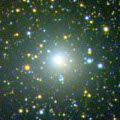
|
It reached up to 7.7 mag in 2009 summer (2009 Aug. 13, Chris Wyatt). Now it is fading. It has already faded down to 15.5 mag (May 31, Hidetaka Sato). It will never be observable again in the Northern Hemisphere. In the Southern Hemisphere, it keeps observable in good condition until 2011 autumn when it becomes fainter than 18 mag.
Date(TT) R.A. (2000) Decl. Delta r Elong. m1 Best Time(A, h)
May 28 17 5.72 -65 14.6 6.074 6.833 135 16.0 0:48 ( 0, 60)
June 4 16 51.81 -65 26.1 6.105 6.881 136 16.1 0:06 ( 0, 60)
|

|
It is expected to keep 14-15 mag for a long time from 2011 summer to 2012 summer. The condition is good in the Southern Hemisphere, and it keeps observable for a long time. In the Northern Hemisphere, it is observable in the low sky in 2011 spring. But after that, it is not observable until 2012 August. However, this comet was observed only during two days in 2010 June. So the orbital elements are extremely uncertain.
Date(TT) R.A. (2000) Decl. Delta r Elong. m1 Best Time(A, h)
May 28 18 7.71 -38 35.2 2.679 3.597 150 16.2 1:49 ( 0, 86)
June 4 17 57.76 -40 28.3 2.590 3.543 156 16.1 1:11 ( 0, 85)
|
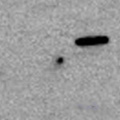
|
Now it is 16.1 mag (May 26, Hidetaka Sato). It brightens up to 12 mag in autumn. But the condition is bad. In the Northern Hemisphere, the altitude will be lower than 20 degree in June when it brightens up to 15 mag, then it will be unobservable in August. After the perihelion passage, it is only observable from December to February in the evening very low sky. In the Southern Hemisphere, it keeps observable for a long time, although it keeps locating extremely low.
Date(TT) R.A. (2000) Decl. Delta r Elong. m1 Best Time(A, h)
May 28 9 14.87 26 58.9 2.189 2.024 67 16.5 18:27 (157, 24)
June 4 9 24.10 25 52.4 2.204 1.961 62 16.2 18:25 (153, 24)
|
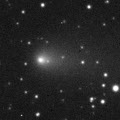
|
It became bright as 12 mag in 2010. Appearing in the morning sky in the Southern Hemisphere. It will be observable also in the Northern Hemisphere in mid June.
Date(TT) R.A. (2000) Decl. Delta r Elong. m1 Best Time(A, h)
May 28 1 26.59 0 50.4 4.083 3.462 46 16.3 5:27 (247, 27)
June 4 1 33.81 1 29.2 4.030 3.483 51 16.3 5:30 (242, 32)
|
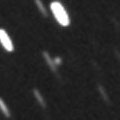
|
Now it is 16.1 mag (Apr. 2, B. Haeusler). It is expected to be 14 mag and will be observable in good condition in 2013. In the Northern Hemisphere, it keeps observable for a long time after this. It is not observable in the Southern Hemisphere.
Date(TT) R.A. (2000) Decl. Delta r Elong. m1 Best Time(A, h)
May 28 2 1.40 56 7.0 8.440 7.728 42 16.5 5:27 (211,-16)
June 4 2 3.35 56 39.7 8.378 7.698 45 16.5 5:30 (208,-13)
|

|
Now it is 17.3 mag (May 14, Ken-ichi Kadota). It will brighten rapidly, and will be observable at 15 mag in good condition from July to October. It locates somewhat low in the Northern Hemisphere.
Date(TT) R.A. (2000) Decl. Delta r Elong. m1 Best Time(A, h)
May 28 20 35.84 -14 52.3 1.798 2.450 118 16.7 4:16 (180, 70)
June 4 20 39.44 -15 10.8 1.712 2.435 124 16.5 3:52 (180, 70)
|
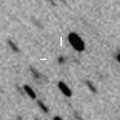
|
Now it is 16.9 mag (May 28, C. Bell). It will brighten up to 16 mag from summer to autumn, and will be observable in good condition.
Date(TT) R.A. (2000) Decl. Delta r Elong. m1 Best Time(A, h)
May 28 16 28.08 -2 17.7 1.343 2.324 160 16.6 0:09 (180, 57)
June 4 16 23.57 -1 44.2 1.322 2.297 158 16.5 23:33 (180, 57)
|

|
Peculiar asteroid with a comet-like orbit. It approaches to the sun down to 0.1 A.U. on July 3. It moves along a very similar orbit to that of 2008 HE, which passes the perihelion on July 29. Now it is 17.0 mag (May 21, La Sagra). Now it is passing close to the earth down to 0.1 A.U., and observable in an excellent condition.
Date(TT) R.A. (2000) Decl. Delta r Elong. m1 Best Time(A, h)
May 28 15 39.70 42 50.6 0.080 1.050 115 16.5 22:45 (180, 5)
June 4 7 30.14 47 35.0 0.148 0.908 41 21.3 18:25 (144, -6)
|

|
It had been bright as 13-14 mag for a long time from 2007 to 2009. Now it is fading slowly, but it is still bright as 16.1 mag (Apr. 28, Artyom Novichonok). It is observable in good condition in the Northern Hemisphere. It locates low in the Southern Hemisphere.
Date(TT) R.A. (2000) Decl. Delta r Elong. m1 Best Time(A, h)
May 28 10 33.32 40 40.2 10.187 10.046 79 16.6 18:27 (177, 14)
June 4 10 32.40 40 16.9 10.326 10.082 73 16.6 18:25 (172, 14)
|
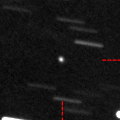
|
It is expected to be bright as 9 mag from 2012 to 2013. Now it is 16.3 mag (May 25, Toshiyuki Takahashi). In the Northern Hemisphere, it keeps observable in good condition for a long time until 2012 autumn when the comet brightens up to 10 mag. In the Southern Hemisphere, it is hardly observble before the perihelion passage. But it becomes observable in good condition since 2013 after the perihelion passage.
Date(TT) R.A. (2000) Decl. Delta r Elong. m1 Best Time(A, h)
May 28 11 30.53 63 29.5 6.539 6.419 78 16.7 19:08 (180, -8)
June 4 11 30.71 62 38.3 6.545 6.362 75 16.6 18:41 (180, -8)
|
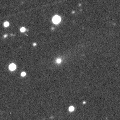
|
Now it is 17.0 mag (May 13, J. F. Soulier). It was observed around 16 mag in 2009 and 2010. In 2011, it keeps observable at 17 mag from spring to autumn. It locates somewhat low in the Northern Hemisphere.
Date(TT) R.A. (2000) Decl. Delta r Elong. m1 Best Time(A, h)
May 28 17 25.97 -23 23.9 3.142 4.125 163 16.8 1:07 (180, 78)
June 4 17 21.34 -23 27.5 3.127 4.134 171 16.8 0:35 (180, 78)
|
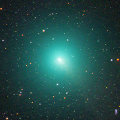
|
It approached to the earth down to 0.12 A.U. and brightened up to 4.6 mag in October (Oct. 18, Juan Jose Gonzalez). It was very large, double of the full moon, and very bright, visible with naked eyes. Now it is fading. It has already faded down to 16.3 mag (May 22, Artyom Novichonok). It will be getting lower after this, and will be unobservable in June.
Date(TT) R.A. (2000) Decl. Delta r Elong. m1 Best Time(A, h)
May 28 9 4.16 4 55.6 2.775 2.630 71 16.9 18:27 (143, 43)
June 4 9 13.85 4 39.3 2.914 2.685 66 17.1 18:25 (138, 41)
|

|
Now it is 17.3 mag (May 23, Tzec Maun Observatory). It will brighten up to 13 mag in next winter. But the condition of this apparition is bad, and it will not be observable around the perihelion passage. It will be observable until July when it brightens up to 16 mag in the Northern Hemisphere, or until September when it brightens up to 15 mag in the Southern Hemisphere.
Date(TT) R.A. (2000) Decl. Delta r Elong. m1 Best Time(A, h)
May 28 10 30.28 19 3.1 2.213 2.370 86 17.0 18:27 (175, 36)
June 4 10 36.15 17 57.3 2.261 2.331 81 16.9 18:25 (169, 36)
|
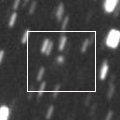
|
Now it is 16.8 mag (May 30, C. Rinner, F. Kugel). In the Northern Hemisphere, it keeps observable at 17 mag in good condition until summer. It locates low in the Southern Hemisphere.
Date(TT) R.A. (2000) Decl. Delta r Elong. m1 Best Time(A, h)
May 28 16 13.07 42 20.0 3.627 4.176 116 17.2 23:48 (180, 13)
June 4 15 56.66 42 35.9 3.680 4.197 114 17.3 23:05 (180, 12)
|

|
Now it is 16.7 mag (May 28, Hidetaka Sato). It will be observable in good condition at 17.5 mag in 2011 spring in the Southern Hemisphere, and at 17 mag in next winter in the Northern Hemisphere.
Date(TT) R.A. (2000) Decl. Delta r Elong. m1 Best Time(A, h)
May 28 11 25.39 -15 9.1 1.963 2.511 111 17.5 19:02 (180, 70)
June 4 11 13.58 -11 55.3 2.071 2.471 100 17.5 18:25 (179, 67)
|

|
Now it is 17.1 mag (May 17, Hidetaka Sato). It will be observable at 17 mag in good condition from summer to autumn.
Date(TT) R.A. (2000) Decl. Delta r Elong. m1 Best Time(A, h)
May 28 22 23.21 -15 14.0 1.777 2.109 94 17.6 5:27 (205, 69)
June 4 22 33.74 -14 48.9 1.703 2.104 98 17.5 5:30 (191, 69)
|

|
Now it is 17.4 mag (May 28, L. Buzzi). It will approach to the sun down to 0.1 A.U. in July and August. It is not observable around the perihelion passage. But it is observable in good condition at 17.5 mag in June.
Date(TT) R.A. (2000) Decl. Delta r Elong. m1 Best Time(A, h)
May 28 16 32.39 -5 53.8 0.486 1.486 164 17.9 0:15 (180, 61)
June 4 15 48.16 -0 20.3 0.390 1.375 153 17.5 22:53 (180, 55)
|
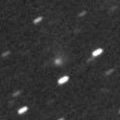
|
Now it is 17.2 mag (May 26, Catalina Sky Survey). It is fading slowly. In the Northern Hemisphere, it keeps observable in good condition until 2011 summer. It is not observable in the Southern Hemisphere.
Date(TT) R.A. (2000) Decl. Delta r Elong. m1 Best Time(A, h)
May 28 16 34.07 47 22.2 5.279 5.724 111 17.8 0:15 (180, 8)
June 4 16 25.82 46 42.6 5.313 5.752 110 17.8 23:34 (180, 8)
|

|
It will brighten up to 15 mag in autumn and winter. But the condition of this apparition is bad. It is not observable around the perihelion passage. It will be getting lower in the evening sky after this. In the Southern Hemisphere, it will be observable until September when it brightens up to 16 mag. In the Northern Hemisphere, it is observable only until July.
Date(TT) R.A. (2000) Decl. Delta r Elong. m1 Best Time(A, h)
May 28 11 11.28 -5 15.9 1.940 2.403 104 18.1 18:49 (180, 60)
June 4 11 14.66 -5 23.8 1.984 2.361 98 17.9 18:25 (180, 60)
|
|
![]()
 62P/Tsuchinshan 1
62P/Tsuchinshan 1 29P/Schwassmann-Wachmann 1
29P/Schwassmann-Wachmann 1 C/2010 G2 ( Hill )
C/2010 G2 ( Hill ) C/2006 S3 ( LONEOS )
C/2006 S3 ( LONEOS ) C/2010 X1 ( Elenin )
C/2010 X1 ( Elenin ) (596) Scheila
(596) Scheila 9P/Tempel 1
9P/Tempel 1 C/2009 Y1 ( Catalina )
C/2009 Y1 ( Catalina ) C/2011 A3 ( Gibbs )
C/2011 A3 ( Gibbs ) 27P/Crommelin
27P/Crommelin 240P/2010 P1 ( NEAT )
240P/2010 P1 ( NEAT ) C/2008 FK75 ( Lemmon-Siding Spring )
C/2008 FK75 ( Lemmon-Siding Spring ) C/2006 W3 ( Christensen )
C/2006 W3 ( Christensen ) C/2010 M1 ( Gibbs )
C/2010 M1 ( Gibbs ) 73P/Schwassmann-Wachmann 3
73P/Schwassmann-Wachmann 3 65P/Gunn
65P/Gunn C/2010 S1 ( LINEAR )
C/2010 S1 ( LINEAR ) 48P/Johnson
48P/Johnson 115P/Maury
115P/Maury 2011 KE
2011 KE C/2005 L3 ( McNaught )
C/2005 L3 ( McNaught ) C/2011 F1 ( LINEAR )
C/2011 F1 ( LINEAR ) 74P/Smirnova-Chernykh
74P/Smirnova-Chernykh 103P/Hartley 2
103P/Hartley 2 71P/Clark
71P/Clark C/2009 UG89 ( Lemmon )
C/2009 UG89 ( Lemmon ) C/2011 G1 ( McNaught )
C/2011 G1 ( McNaught ) 130P/McNaught-Hughes
130P/McNaught-Hughes 2008 HE
2008 HE C/2007 VO53 ( Spacewatch )
C/2007 VO53 ( Spacewatch ) 37P/Forbes
37P/Forbes![]()
























